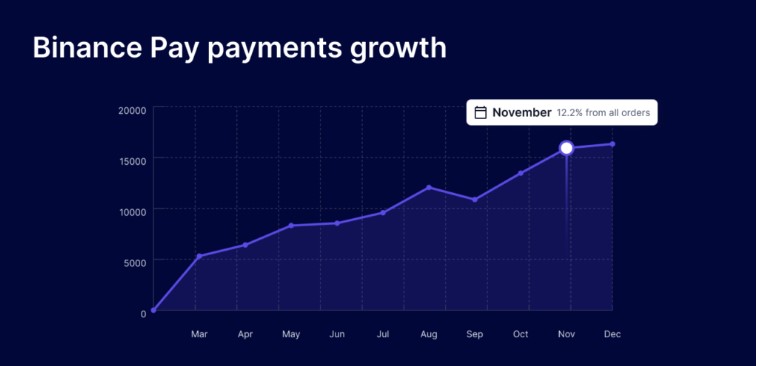Bitcoin-focused payments firm Strike is expanding its services to African countries including Nigeria, South Africa and Zambia, the company announced in a blog post Tuesday.
Which Is the Best Self-Custody Lightning Wallet?
Bitcoin educator Anita Posch tested the Blixt, Green, Mutiny, Phoenix and Zeus Lightning wallets while traveling in Zimbabwe.
Bitcoin Could See Growth in Layer-2 Ecosystem, Drawing on Ethereum’s Experience: Report
The report by Singapore-based blockchain investment Spartan Group and Kyle Ellicott details how these auxiliary networks have drawn a page from the Ethereum blockchain’s playbook, and could spring up as demand grows for blockspace on Bitcoin.
Crypto Payments Soared To Unprecedented Levels In 2023, CoinGate Report Reveals
The year 2023 witnessed a remarkable surge in crypto payments, signaling a significant milestone in adopting digital currencies for retail and e-commerce transactions.
According to a recent report by CoinGate, a crypto payment processor firm, the number of crypto payments processed reached staggering heights, showcasing robust growth and diversification in the crypto landscape.
Massive Surge In Crypto Payments
In 2023, CoinGate processed an astounding 1,294,058 cryptocurrency payments, marking a 39.4% increase compared to the previous record. This exponential growth, equivalent to one payment every 24 seconds, underscores the accelerating pace of crypto adoption.
Notably, approximately one-third (32.35%) of all transactions processed by CoinGate in the last ten years occurred in 2023, emphasizing the surge in the popularity of digital currencies.
Per the report, integrating Binance Pay wallet into CoinGate’s payment services in March 2023 played a significant role in driving this growth.

Binance Pay accounted for 8.2% of all crypto payments in 2023, showcasing a steady increase in usage throughout the year. This upward trend, from 4.5% in March to 13% in December, indicates the growing adoption and usage of Binance Pay as a preferred payment method.
Lightning Network Surges In Popularity
Moreover, CoinGate’s report highlights the increasing maturity and acceptance of the Lightning Network, an essential component of Bitcoin payments.
In 2023, the Lightning Network facilitated 7.8% of all Bitcoin payments processed by CoinGate, representing a notable increase from previous years.
Furthermore, the overall number of Lightning Network payments grew by 35.9% compared to the previous year, indicating a growing reliance on this technology.
However, Bitcoin, long considered the dominant cryptocurrency for payments, saw a decline in its share of total transactions processed by CoinGate. While Bitcoin accounted for 54.8% of all transactions in 2021, its share dropped to 35.6% in 2023.
Stablecoins, particularly Tether’s USDT, emerged as a popular choice for crypto payments in 2023. The usage of USDT increased from 15.1% in 2022 to an average of 25.4% in 2023, indicating a shift towards stablecoins due to their perceived stability and reliability.
Alternative Payment Solutions
According to CoinGate’s report, crypto-friendly merchants experienced remarkable success in 2023, with a significant portion of their sales attributed to cryptocurrency payments.
Eldorado.gg, a gold and accounts marketplace for gamers, reported crypto payments contributing to 3% of their total sales. IPRoyal, a proxy service provider, saw over 30% of their payments made in cryptocurrencies.
Hostinger, a web hosting provider, captured nearly one-fourth of all crypto-paying customers, showcasing the effectiveness of alternative payment solutions in catering to diverse customer needs.
Overall, 2023 demonstrated a paradigm shift in the adoption of cryptocurrency payments. The surge in transactions processed by CoinGate, the increasing usage of Binance Pay and the Lightning Network, and the diversification of cryptocurrencies used for payments all point towards a new era of acceptance and trust in digital currencies.
As crypto-friendly merchants reap the benefits of embracing these payment methods, it becomes evident that cryptocurrency payments offer sales growth, solutions for the unbanked population, and global accessibility.
With the stage set for further expansion in 2024, the transformative power of cryptocurrency payments continues to reshape the retail and e-commerce landscape.
Featured image from Shutterstock, chart from TradingView.com
Ethereum, Bitcoin users reignite scalability debate as gas fees surge

Ethereum gas fees reportedly breached the $200-mark for certain high-priority transactions in the last 24 hours.
El Salvador Bitcoin ATM network to receive Lightning Network upgrade

Athena Bitcoin plans to integrate the Lightning Network into 100 of its machines in the next couple of months.
Bulgaria’s oldest football club adopts Bitcoin and Lightning, joins Nostr

Football meets finance: Bitcoin payments integration arrives at top-flight Bulgarian club, Botev Plovdiv FC.
Lightning Network faces criticism from pro-XRP lawyer John Deaton

John Deaton’s remarks come amid concerns about alleged backdoors in the Bitcoin Lightning Network’s code.
Bitcoin core developer steps back from Lightning Network over “hard dilemma”

Antoine Riard believes the Bitcoin community faces a “hard dilemma” as a new class of replacement cycling attacks threatens the Lightning Network.
Crypto Biz: PayPal rolls out crypto ramps, Franklin Templeton joins BTC ETF race, and more

This week’s Crypto Biz looks at PayPal’s crypto gateway, Franklin Templeton’s BTC ETF filing, Coinbase’s Lightning Network integration, and Meta’s plans for a new AI model.
How to identify and protect against routing attacks in the Lightning Network

To protect against routing attacks in the Lightning Network, utilize watchtowers, verify channel state changes, and prioritize well-established payment channels.
Coinbase CEO Confirms Exchange Will Support Lightning, Which Dramatically Speeds Up Bitcoin Payments
Coinbase CEO Brian Armstrong says the crypto exchange will indeed add support for the Lightning Network, one of the biggest endorsements yet for the blockchain that makes bitcoin (BTC) a more realistic option for payments by dramatically speeding up transactions.
Coinbase to integrate Bitcoin Lightning network: CEO Brian Armstrong

Lighting Network helps Bitcoin solve its scalability problem and compete against newer cryptocurrency projects that promised comparatively faster and cheaper transactions.
Privacy prevails and cypherpunks write code at Baltic Honeybadger

The Riga cypherpunk reunion convened around the Lightning Network, privacy and a strong anti-CBDC sentiment.
Bitcoin gains traction in West Africa with educational drive
As anti-French sentiment rides high in West Africa, Bitique opens its doors, the “Bitcoin Mastermind” conference beckons and more nodes come online to verify the Bitcoin blockchain.
Free Bitcoin on Zaps experiment — but what are Zaps?

Why a Canadian Bitcoin advocate is giving out free Bitcoin tips, or Zaps, to people around the globe–and why the Zap trend is catching on.
Bitcoin Lightning on Coinbase agenda, Brian Armstrong tells Jack Dorsey

Armstrong confirmed that Coinbase was looking into adding support for Bitcoin Lightning while reassuring his support for Bitcoin payments.
Lightspark CEO Outlines The Challenges Of Building On The Bitcoin Lightning Network
The CEO of Lightspark, David Marcus, has come forward to share his experiences on building atop the Bitcoin Lightning Network. Marcus noted the challenges the Lightning Network held for builders, stating that it was incredibly difficult and complex to develop software around the protocol.
The Bitcoin Lightning Network And The Challenges It Holds for Builders
According to the Lightspark CEO, a firm involved in developing payment solutions on the Lightning Network, a layer-2 scaling platform for Bitcoin, the firm decided to build on the network because of the “unique qualities” Bitcoin provides as the underlying network.
He explained that Lightspark’s objective is to build a cheap, very open, and interoperable protocol for virtual money/payments, and the Lightning Network is designed to be similar to layer 2 ZK-rollup for Bitcoin.
However, the former president of Paypal and co-creator of Diem noted that building on Lightning and Bitcoin is about five times more difficult than developing on other protocols. This is because the process to create software around the protocol is incredibly difficult and complex to do.
Nevertheless, with these objectives in mind, the platform committed to building on the Bitcoin Lightning Network and to do “Whatever it takes to reach their full potential.” But despite having high hopes about the prospects of the network, Marcus’s recent disclosures on Twitter have shown that building on the network was no easy feat.
Moving Forward Despite Difficulties
According to Marcus, part of the challenges is attributed to the rigidity of Bitcoin and the difficulties involved in altering its structure to contain new code in its base layers to meet the needs of specific solutions. He pointed out that Bitcoin’s layer 1 is particularly rigid and building a new opcode to mainlet was practically not possible.
However, despite these challenges, Lightspark remains upbeat, and instead of completely abandoning the Lightning Network protocol for other less complex chains, the platform intends to develop a payment solution that would still be applicable “100 years from now.”
The firm also intends to reorganize the process enabling crypto market users to connect to the Lightning Network. Although this will depend on their ability to put in place the necessary peer-to-peer payment channels.
Apart from Lightspark’s CEO, other players in the sector have also recognized the intricacies and general challenges of building software around the Lightning Network. Popular CEO of Binance Changpeng Zhao has previously pointed out that integrating Lightning Network services on Binance was more complex because of the usage of on-demand invoices, which are different from pre-generated addresses.
Additionally, Fitatjaf, a prominent Bitcoin developer and founder of the decentralized social protocol Nostr, has also offered criticism of the Lightning Network, terming it a pile of complex and ugly hacks.
From rugs to riches: UK carpet retailer to adopt Bitcoin Standard

With inflation running high and sluggish UK banking interest rates, small businesses in the United Kingdom are turning to novel solutions to save money.
Lightning Network Bitcoin Deposits Now Live on Binance
Bitcoin holders that want to deposit their assets to crypto exchange Binance using the lightning network, a bitcoin scaling solution.
